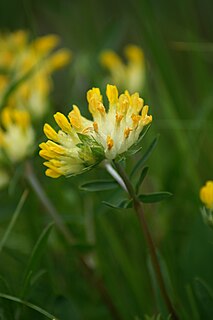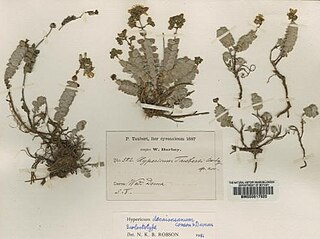
Crambe is a genus of annual and perennial flowering plants in the family Brassicaceae, native to a variety of habitats in Europe, Turkey, southwest and central Asia and eastern Africa. They carry dense racemes of tiny white or yellow flowers on stems above the basal leaves. Crambe hispanica subsp. abyssinica, formerly known as Crambe abyssinica, is grown for the oil from the seeds that has characteristics similar to whale oil.

Anthemis is a genus of aromatic flowering plants in the family Asteraceae, closely related to Chamaemelum, and like that genus, known by the common name chamomile; some species are also called dog-fennel or mayweed. Anthemis are native to the Mediterranean region and southwest Asia east to Iran. A number of species have also become naturalized in the United Kingdom and other parts of the world.

Polygala is a large genus of flowering plants belonging to the family Polygalaceae. They are commonly known as milkworts or snakeroots. The genus is distributed widely throughout much of the world in temperate zones and the tropics. The genus name Polygala comes from the ancient Greek "much milk", as the plant was thought to increase milk yields in cattle.

Koncordie Amalie Dietrich was a German naturalist who was best known for her work in Australia from 1863 to 1872, collecting specimens for the Museum Godeffroy in Hamburg. In Queensland, Australia, Dietrich "actively sought fresh Aboriginal skeletons for her European clients”. While this is most likely part of a local legend that presents Dietrich as the 'Angel of Black Death, it is a proven fact that she did send the human remains of several Indigenous Australians to Hamburg. Her contribution to colonialism – pertaining to both the anthropological as well as the botanical aspect – are the subject of recent academic debates.

Anthyllis is a genus of flowering plants in the family Fabaceae. This genus contains both herbaceous and shrubby species and is distributed in Europe, the Middle East and North Africa. The most widespread and familiar species is A. vulneraria, a familiar grassland flower which has also been introduced to New Zealand.

Polygaloides paucifolia, synonym Polygala paucifolia, known as gaywings or fringed polygala, is a perennial plant of the family Polygalaceae.

Polygaloides chamaebuxus, synonym Polygala chamaebuxus, the shrubby milkwort, is an ornamental plant in the family Polygalaceae. Its flowers are solitary or in pairs in the leaf axils. The inner two sepals, the wings, are upright and white to yellow, sometimes pinkish or purple. The keel petals are bright yellow, aging to brownish-red or purple. It is native to the Alps and the mountains of west-central Europe. It was known to be grown in cultivation in about 1658 and was illustrated by Carolus Clusius. It has been given the Royal Horticultural Society's Award of Garden Merit.

Eleocharis quinqueflora is a species of spikesedge known by the common names fewflower spikerush and few-flowered spike-rush. It is widespread across Europe, North Africa, northern Asia, and North America. There are also isolated populations in Argentina and Chile.
Salvia taraxacifolia is a species of flowering plant in the Lamiaceae family. It is referred to by the common name Dandelion leaved sage and is a herbaceous perennial shrub that is endemic to southwest Morocco, growing in the Atlas Mountains at elevations ranging from 2,000 feet (610 m) to 8,000 feet (2,400 m). Very adaptable, it grows on limestone slopes, forest clearings, and rocky riversides. It has no close allies in the genus Salvia. The specific epithet, taraxacifolia, is likely Persian in origin and means 'leaves shaped like a dandelion'.
Streptanthus polygaloides is a species of flowering plant in the mustard family known by the common name milkwort jewelflower. It is endemic to the Sierra Nevada foothills of California, where it grows in woodlands and chaparral, generally on serpentine soils.
Blepharodon is a genus of plant in the family Apocynaceae, first described as a genus in 1844. They are native primarily to South America, with one species extending into Central America and Mexico.

Polygala vayredae is a species of flowering plant in the milkwort family (Polygalaceae). It is endemic to the Pyrenees in Spain.
Dicranolepis is a genus of flowering plants belonging to the family Thymelaeaceae.
Rytidocarpus is a genus of flowering plants belonging to the family Brassicaceae.

Rupicapnos is a genus of flowering plants belonging to the family Papaveraceae.
Guiraoa is a monotypic genus of flowering plants belonging to the family Brassicaceae. It only contains one species, Guiraoa arvensisCoss.
Geocaryum is a genus of flowering plants belonging to the family Apiaceae.
Kremeriella is a monotypic genus of flowering plants belonging to the family Brassicaceae. It has one known synonym KremeriaCoss. & Durieu. It only contains one species, Kremeriella cordylocarpus(Coss. & Durieu) Maire
Selinopsis is a genus of flowering plants belonging to the family Apiaceae.

Hypericum decaisneanum is a species of flowering plant of the St. John's wort family (Hypericaceae) that is found in the Libya.











